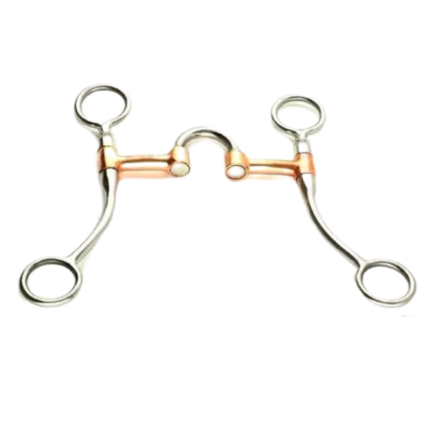Western bits encompass a wide range of styles and designs tailored to the needs of Western riding disciplines. They vary in terms of their mouthpieces, shanks, and overall functionality, catering to different levels of training, riding styles, and horse preferences. Here’s an overview of Western bits:
Types of Western Bits:
- Snaffle Bit:
- Design: A basic bit with a jointed or solid mouthpiece, often with D-shaped or O-shaped rings.
- Functionality: Applies direct pressure on the horse’s mouth, suitable for young or green horses or riders who prefer direct rein aids.
- Curb Bit:
- Design: Features a mouthpiece with shanks on either side, which can vary in length and angle. The shanks may have a variety of designs, including swept-back, straight, or curved.
- Functionality: Applies leverage, exerting pressure on the horse’s poll and chin groove in addition to the mouth, providing more nuanced communication and control.
- Tom Thumb Bit:
- Design: A type of curb bit with short shanks and a jointed mouthpiece.
- Functionality: Offers some leverage action but is less severe than traditional curb bits, making it popular for young horses or riders transitioning from a snaffle bit.
- Ported Bit:
- Design: Features a raised or arched center portion (the port) on the mouthpiece, allowing more room for the horse’s tongue.
- Functionality: Provides tongue relief and may exert pressure on the palate, suitable for horses that prefer tongue relief or have low palates.
- Correction Bit:
- Design: Similar to a curb bit but with additional features such as swiveling or jointed mouthpieces and longer shanks with multiple rein attachment options.
- Functionality: Offers subtle correction and refinement in communication, often used by experienced riders for fine-tuning the horse’s responses.
Key Considerations:
- Training Level: Choose a bit appropriate for your horse’s training level and experience. Young or green horses may start with a simple snaffle bit before progressing to a curb or correction bit as they advance.
- Riding Discipline: Consider the specific demands of your chosen Western riding discipline, whether it’s reining, cutting, barrel racing, or trail riding, and select a bit that aligns with those requirements.
- Horse Comfort: Pay attention to your horse’s response to different bits, ensuring they are comfortable and responsive to the chosen bit’s cues. Regular bit fitting and adjustment are essential.
- Rider Skill Level: Some Western bits require a nuanced understanding of rein aids and subtle cues. Choose a bit that matches your skill level and riding style to ensure effective communication with your horse.
Proper Fit and Adjustment:
- Ensure the bit fits comfortably in the horse’s mouth without causing pinching or discomfort.
- Adjust the bit’s placement and bridle fit to achieve proper contact and communication without excessive pressure.
Maintenance:
- Regularly clean and inspect your Western bit to ensure its proper function and longevity.
- Check for signs of wear, corrosion, or damage and address any issues promptly to maintain your horse’s comfort and safety.







Reviews
There are no reviews yet.